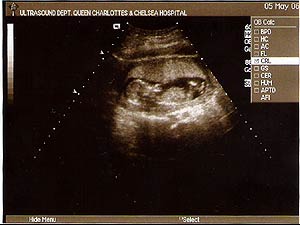Friday, June 30, 2006
Thursday, June 29, 2006
Thanks for the war, Mr President. Now let's go jogging.
Tuesday, June 27, 2006
My article about the Creative Growth art centre in Oakland, California, is finally online.
Read it here.
Read it here.
Sunday, June 18, 2006
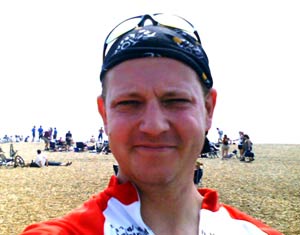 On a beautifully hot day like today it's time to head to the beach -- by bike.
On a beautifully hot day like today it's time to head to the beach -- by bike.I joined 27,000 other cyclists for the annual London to Brighton bike ride.
The biggest problem wasn't the heat -- it was the congestion. The event is just too big. I've been stuck in plenty of traffic jams but a bike jam caused by thousands of cyclists squeezing up the same country lanes was something new.
Anyone who gets on their bikes and cycles 54 miles should be applauded -- but many of the participants looked as though they were back in the saddle for the first time since they were children. At the sight of the first hillock they dismounted and started pushing -- causing massive tailbacks behind them.
A fun day out -- but probably not one I'd repeat.
Friday, June 16, 2006
Now this is my kind of company.
Thursday, June 15, 2006
Met up this afternoon with Fiona Callanan, a fellow RBK who lost her leg in the Asian tsunami on Boxing Day 2004.
Like another certain amputee I know, Fiona's not prepared to sit back and accept a life with limitations.
She's training to cycle from Saigon to Angkor Wat in Cambodia to raise money for the Cambodia Trust.
I'm encouraging Fiona to join me on a run sometime in the months ahead.
In the meantime, I strongly encourage you to sponsor her. Tell her I sent you!
Like another certain amputee I know, Fiona's not prepared to sit back and accept a life with limitations.
She's training to cycle from Saigon to Angkor Wat in Cambodia to raise money for the Cambodia Trust.
I'm encouraging Fiona to join me on a run sometime in the months ahead.
In the meantime, I strongly encourage you to sponsor her. Tell her I sent you!
Sunday, June 11, 2006
It's taken me a while to write up, but this article based on my visit to the Creative Growth Centre in Oakland, CA should be appearing on BBC News Online in the nexxt few days.
RAW VISION OF THE OUTSIDER ARTISTS
Oakland, California
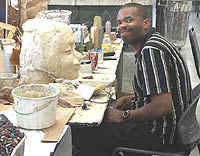 Artist William Scott sinks his hands into a mass of soft, wet clay.
Artist William Scott sinks his hands into a mass of soft, wet clay.
Using his thumbs he carefully shapes the clay into the nose of an Afro-American basketball player.
Scott recently sold out a one-man show of his striking ceramic busts at the prestigious White Columns Gallery in New York. His work has been displayed at galleries across the United States and Europe and is sought after by art collectors worldwide.
William Scott is also severely autistic.
He is one of 150 artists with mental and physical disabilities based at the Creative Growth Art Centre, a former car repair workshop in the industrial district of Oakland, near San Francisco.
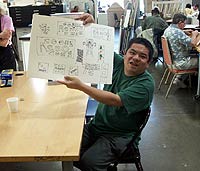 The artists working there are some of the leading figures in what is known as the “Outsider Art” movement.
The artists working there are some of the leading figures in what is known as the “Outsider Art” movement.
The term Outsider Art, or art brut as it is sometimes known, is used to describe works by artists with no formal training operating outside the mainstream, often on the fringes of society.
Creative Growth was founded in 1974 by clinical psychologist Elias Katz and his wife Florence, an artist. Though the project has grown to become the longest-running and largest centre of its kind in the world, its mission remains unchanged.
“We want to create a place where people can express themselves in a non-pressurised environment,” explains Cathy Perillo, Creative Growth’s studio manager.
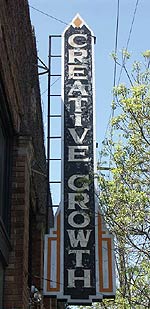 Many of the staff working at Creative Growth are working artists. They insist, however, that the centre is not an art school and their aim is not to teach their students how to draw and paint.
Many of the staff working at Creative Growth are working artists. They insist, however, that the centre is not an art school and their aim is not to teach their students how to draw and paint.
“One of the things that sets Creative Growth apart is that we don’t giving the artists instruction,” says gallery manager Jennifer O’Neal.
“We just provide the materials and an environment in which they can express themselves. The work here is not being taught.
“Everything comes straight from the artists.”
The artists at Creative Growth receive half of the proceeds from the sale of their work. The remaining profits help fund the running of the centre and a percentage is shared equally among all of the artists working there.
Although the sale of their works gives many Creative Growth artists a degree of financial independence for the first time in their lives, Jennifer O’Neal insists commercial considerations are never allowed to come before the needs of the individual.
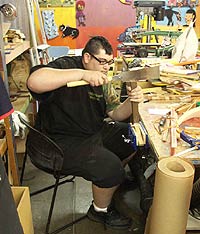 “Sometimes artists will decide they don’t want to show their work publicly or they don’t want to get paid for their work because it puts them under pressure,” she says.
“Sometimes artists will decide they don’t want to show their work publicly or they don’t want to get paid for their work because it puts them under pressure,” she says.
“When that happens, we stop. We never forget that we’re here for the artists above everything else.”
Art created by individuals on the margins of society first began to attract wider interest in the 1920s with the publication of a study of the work of Adolf Wölfli, a prolific Swiss artist who spent most of his life in a psychiatric hospital suffering from severe mental illness.
Stan Peterson, who has worked at Creative Growth since its foundation, believes outsider art has a universal resonance.
“All contemporary art is about searching for something that’s fresh, raw and primitive,” he says.
“The work created here is vital and fresh.
“There’s so much talent here and it has influenced my own work for the better. It has made me looser and more open to new ideas,” Peterson says.
“It’s so much more satisfying being here than in a university or an art school where there are so many egos and so much competition.
“That just doesn’t exist at Creative Growth.
“Here, it’s just about the act of making things.”
RAW VISION OF THE OUTSIDER ARTISTS
Oakland, California
 Artist William Scott sinks his hands into a mass of soft, wet clay.
Artist William Scott sinks his hands into a mass of soft, wet clay.Using his thumbs he carefully shapes the clay into the nose of an Afro-American basketball player.
Scott recently sold out a one-man show of his striking ceramic busts at the prestigious White Columns Gallery in New York. His work has been displayed at galleries across the United States and Europe and is sought after by art collectors worldwide.
William Scott is also severely autistic.
He is one of 150 artists with mental and physical disabilities based at the Creative Growth Art Centre, a former car repair workshop in the industrial district of Oakland, near San Francisco.
 The artists working there are some of the leading figures in what is known as the “Outsider Art” movement.
The artists working there are some of the leading figures in what is known as the “Outsider Art” movement.The term Outsider Art, or art brut as it is sometimes known, is used to describe works by artists with no formal training operating outside the mainstream, often on the fringes of society.
Creative Growth was founded in 1974 by clinical psychologist Elias Katz and his wife Florence, an artist. Though the project has grown to become the longest-running and largest centre of its kind in the world, its mission remains unchanged.
“We want to create a place where people can express themselves in a non-pressurised environment,” explains Cathy Perillo, Creative Growth’s studio manager.
 Many of the staff working at Creative Growth are working artists. They insist, however, that the centre is not an art school and their aim is not to teach their students how to draw and paint.
Many of the staff working at Creative Growth are working artists. They insist, however, that the centre is not an art school and their aim is not to teach their students how to draw and paint.“One of the things that sets Creative Growth apart is that we don’t giving the artists instruction,” says gallery manager Jennifer O’Neal.
“We just provide the materials and an environment in which they can express themselves. The work here is not being taught.
“Everything comes straight from the artists.”
The artists at Creative Growth receive half of the proceeds from the sale of their work. The remaining profits help fund the running of the centre and a percentage is shared equally among all of the artists working there.
Although the sale of their works gives many Creative Growth artists a degree of financial independence for the first time in their lives, Jennifer O’Neal insists commercial considerations are never allowed to come before the needs of the individual.
 “Sometimes artists will decide they don’t want to show their work publicly or they don’t want to get paid for their work because it puts them under pressure,” she says.
“Sometimes artists will decide they don’t want to show their work publicly or they don’t want to get paid for their work because it puts them under pressure,” she says.“When that happens, we stop. We never forget that we’re here for the artists above everything else.”
Art created by individuals on the margins of society first began to attract wider interest in the 1920s with the publication of a study of the work of Adolf Wölfli, a prolific Swiss artist who spent most of his life in a psychiatric hospital suffering from severe mental illness.
Stan Peterson, who has worked at Creative Growth since its foundation, believes outsider art has a universal resonance.
“All contemporary art is about searching for something that’s fresh, raw and primitive,” he says.
“The work created here is vital and fresh.
“There’s so much talent here and it has influenced my own work for the better. It has made me looser and more open to new ideas,” Peterson says.
“It’s so much more satisfying being here than in a university or an art school where there are so many egos and so much competition.
“That just doesn’t exist at Creative Growth.
“Here, it’s just about the act of making things.”
Wednesday, June 07, 2006
My leg may not have attracted as many column inches as Wayne Rooney's today but even so, three quarters of a page in the London Evening Standard isn't bad going.
Monday, June 05, 2006
Coming soon -- one-legged man jumps off building.
Thursday, June 01, 2006
My boss Jonathan Baker, one of the team of people who broke the news of my injury in Iraq to my family, reflects on life at the helm of the (increasingly perilous) foreign news supertanker in this week's From Our Own Correspondent.
UNDER THE INFLUENCE
As regular readers will know, I don't consider myself to be disabled -- not because I regard the term with a sense of shame or embarrassment but because it doesn't seem particularly relevant to me. And I certainly don't consider myself to be influential.
With a limited amount of spare time on my hands, I made a conscious decision early on to focus my energies on the anti-landmine cause -- and to simply get on with my life.
But an e-mail pops into the inbox this morning informing me that I've been nominated for Disability Now's list of the UK's most influential disabled people.
My initial reaction was to throw my hands up and exclaim "no, no -- don't consider me. That label doesn't apply to me."
Then I looked at the list of illustrious and accomplished individuals who've also been nominated -- Alison Lapper, Ade Adepitan, David Blunkett and even our very own Frank Gardner.
If that's the kind of company I'd be among, how could being nominated be anything other than an honour?
As regular readers will know, I don't consider myself to be disabled -- not because I regard the term with a sense of shame or embarrassment but because it doesn't seem particularly relevant to me. And I certainly don't consider myself to be influential.
With a limited amount of spare time on my hands, I made a conscious decision early on to focus my energies on the anti-landmine cause -- and to simply get on with my life.
But an e-mail pops into the inbox this morning informing me that I've been nominated for Disability Now's list of the UK's most influential disabled people.
My initial reaction was to throw my hands up and exclaim "no, no -- don't consider me. That label doesn't apply to me."
Then I looked at the list of illustrious and accomplished individuals who've also been nominated -- Alison Lapper, Ade Adepitan, David Blunkett and even our very own Frank Gardner.
If that's the kind of company I'd be among, how could being nominated be anything other than an honour?
